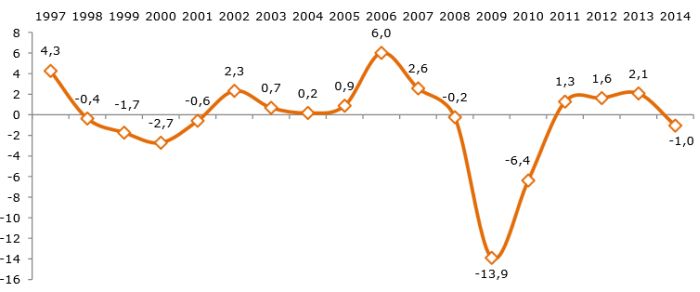Analytics, Employment, Labour-market, Latvia, Markets and Companies
International Internet Magazine. Baltic States news & analytics
Friday, 26.04.2024, 23:52
Employment rates in Latvia still lagging behind the pre-crisis level
 Print version
Print version
The highest employment rate in the last 20 years was registered in 2008, when 62% of the population aged 15-74 years were employed. For comparison, in 2014 employment rate was 59.1%. Employment rate for men during the economic downturn witnessed a more rapid drop than employment rate for women; however, with the labour market situation gradually improving, it is growing faster than for women.
Along with the increase in the retirement age, also the average age of the employed population has been increasing. If in 1996 the average age1 of employed persons was 39.5 years, then in 2014 it was 42.3 years.
 |
| Changes in the number of employees comparing to the previous year |
Changes can also be observed in the trend of the number of hours worked – if in 2002, persons employed in the main job worked on average 41.9 hours weekly, then in 2014 – 38.6 hours.
Over the past 20 years, the lowest unemployment rate was registered in 2007 (6.1%), but during the economic downturn it rapidly increased and still remains relatively high (10.8% in 2014).
Indicators of labour status were also affected by decrease in the number of population – during the time period from from 1996 to 2014, the number of active population declined by 16.8%, and the number of inactive population – by 23.3%.
The number of active young people (aged 15-24) over the last 20 years has decreased by half, and the number of inactive youth – by one fifth. During the period of economic crisis from 2008 to 2010, out of all groups of population, unemployment rate among youth (aged 15-24 years) witnessed the most rapid growth (by 22.6 percentage points), and still remains high (19.6% in 2014).
Labour Force Survey (LFS) is the largest household sample survey, in 2014 surveying almost 43 thousand people. It aims to provide a regular analysis of the Latvian labour market situation, collecting detailed information on the population labour status. The first LFS in Latvia was conducted in 1995. Initially LFS was carried out twice a year, but since 2002 respondents are surveyed continuously throughout the year.
LFS is improved on a regular basis, in line with the methodology of the International Labour Organisation (ILO), also used by Eurostat and the Organisation for Economic Co-operation and Development (OECD), thus ensuring comparability of data at international level.
More information on the Labour Force Survey results is available in the section Employment and Unemployment.
1For the estimates the results of the Labour Force Survey on persons aged 15-74 years have been used.








 «The Baltic Course» Is Sold and Stays in Business!
«The Baltic Course» Is Sold and Stays in Business!

